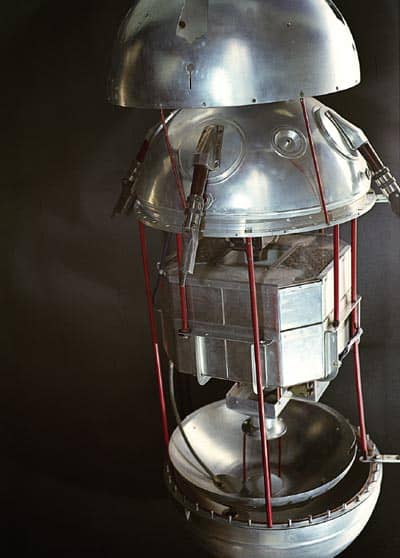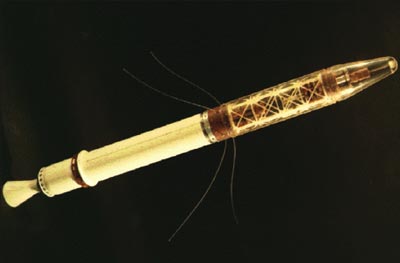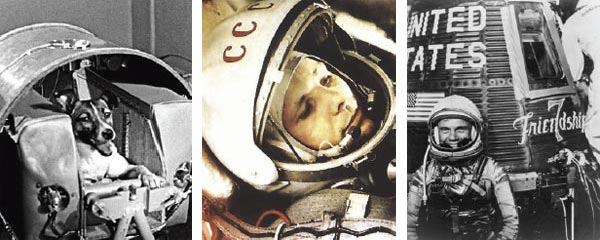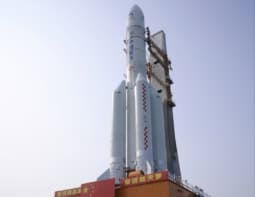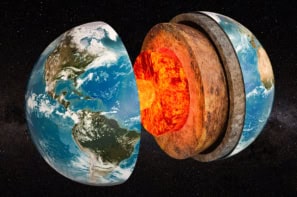The first artificial satellite was little more than a sphere of metal that let out the odd radio-frequency beep, and its only purpose was to demonstrate the superiority of Soviet missile technology. But the launch of Sputnik 1 half a century ago this month has made near-Earth space and the rest of the solar system a much less mysterious place today than it might otherwise have been, explains Richard Corfield
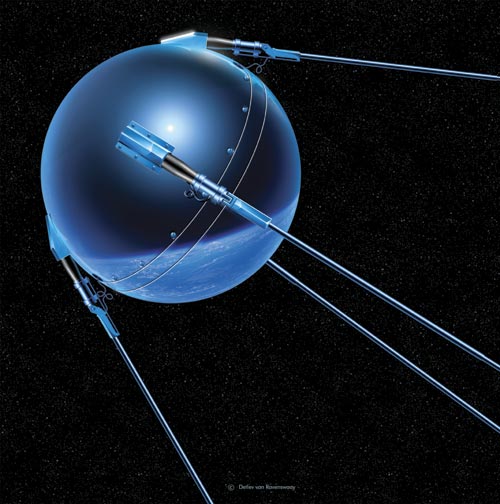
On 8 December 1957 the International Herald Tribune newspaper ran one of the most memorable headlines in the history of space exploration. The single word “Kaputnik!” emblazoned across the front page captured the national mood of humiliation in the US that had followed the country’s disastrous attempt to launch an artificial satellite into orbit from Cape Canaveral two days earlier. The US Navy’s much-hyped Vanguard rocket had managed to raise itself just a few feet from the Merritt Island launch pad before falling back down and exploding. The satellite it had contained — a hastily put together contraption of wires and circuitry designed only to send a radio signal back to Earth — rolled a few feet across the launch pad beeping forlornly.
The timing could not have been much worse. Two months earlier, on 4 October 1957, the Soviet Union had successfully launched the world’s first artificial satellite — Sputnik 1— into Earth orbit, thus simultaneously proving the superiority of Soviet missile technology and kick-starting the space race. This was the reason for the mood of despondency that took hold of the American people two months later in the face of what would normally be considered a routine hazard of flight-testing.
Today it is impossible to overstate the importance of Sputnik’s legacy. Want to know the geography of your holiday destination? Switch on your computer and a magnificent array of satellite images are yours for the browsing, thanks to Google Earth. Stuck in traffic and want a quick way home? Fire up your in-car satellite-navigation system and a network of global positioning satellites will plot your route (see “Global navigation flies high”). Need to speak to a colleague on the other side of the world in real time? Internet conferencing lets you see and hear them simultaneously.
Every one of the hundreds of satellites that underpin our TV, telephone and Internet services is the direct descendant of Sputnik 1. In addition, we also have Sputnik to thank for humankind’s ventures into our cosmic backyard. The chain of events that Sputnik 1 set in motion fuelled the public and political support necessary to get space exploration off the ground. This support has since taken humans to the Moon, while unmanned vehicles are currently exploring the surface of Mars and even sending back data from Titan, Saturn’s most Earth-like moon.
The stage is set
The story of Sputnik 1 can be traced back to the aftermath of the Second World War. While many of the countries that participated in the war were enduring times of stringency, others — like the US — were entering times of unrivalled prosperity. In the US this was a simple consequence of massive wealth and an industrial base that had recovered from the doomed years of the 1930s depression. The war itself resulted in an enormous injection of capital into industries that made munitions.
Meanwhile, the Soviet Union was undergoing even more radical change. After the war it had claimed huge portions of Eastern Europe, so making its territory even larger than that of the US. The stage was set for a conflict that would be based not on national acquisitiveness, as the First and Second World Wars had been, but on something much more frightening. The Cold War was a battle about ideology, and satellite surveillance was a key weapon.
No satellite can make it into orbit without a vehicle to take it there — and in fact, developing a suitable rocket was the most difficult part of getting Sputnik 1 launched. By the end of the Second World War, Germany had developed rocketry to the point where it was routinely raining V-2 missiles on London. Developed under the leadership of the brilliant young engineer Werner Von Braun, these supersonic missiles could cover the distance from northern Germany to Britain in less than six minutes. Londoners wryly commented that you knew you had survived a V-2 attack if you heard the explosion.
The V-2s were fabricated at the Gestapo’s Mittelwerk facility, which was hollowed out of a mountain near Nordhausen in central Germany. The conditions there were horrendous. It was routine to motivate workers by forcing them to watch their compatriots being hanged from the cranes that were used to move rocket components around the giant subterranean factory.
Von Braun himself was a major in the SS (the paramilitary wing of the Nazi Party), but this did not stop the Americans spiriting him out of central Germany via Operation Paperclip in the final days before the Soviet forces overran the area. In late 1945 Von Braun and the bulk of his team were taken — along with many complete V-2 weapons and thousands of components and diagrams — to the White Sands Missile Range rocket development and testing site in New Mexico not far from the “Trinity site”, where the world’s first atomic bomb had been detonated a few months before.
When the Soviets got to Mittelwerk, they found that the area had been almost completely cleared of all evidence of the rocket scientists and their work. The only scientist who had elected to stay was Helmut Gröttrup, yet that single German engineer would turn out to be more than sufficient to revolutionize Soviet missile technology when teamed with one of the most influential rocket scientists of all time: Sergei Korolyov.
Korolyov, like Von Braun, had been fascinated by rockets and the lure of outer space for most of his life. Yet his efforts had not been lauded and supported by a state anxious to capitalize on his work in the way Germany had supported Von Braun. Instead, in the late 1930s Korolyov had been sentenced to penal servitude in the Kolyma uranium mines thanks to the testimony of one of his erstwhile colleagues, the rocket engine specialist Valentin Glushko. Glushko had become a victim of Stalin’s Great Purge of 1938 (in which millions of people who disagreed with Stalin’s style of communism were executed or sent to labour camps) and had denounced Korolyov as an enemy of the Communist Party in order to prove his own loyalty. It was to be 11 years before Korolyov got out of the gulag; when he was eventually released, it was to a world that had changed significantly.
The atomic age
In August 1949 an eye-searing flash of light high over the plains of Kazakhstan announced to the world that the Soviet Union had, like the US four years before, entered the atomic age. The nuclear test, which was the first indication that America’s postwar supremacy was not destined to last for ever, was to have profound and far-reaching consequences for Cold War relations and space exploration. Importantly for Korolyov it also meant that Stalin needed someone to develop the means by which to send nuclear terror over the ocean to his archnemesis — the US.
The US had spent the years following the end of the Second World War capitalizing on the weapons delivery system that had been decisive in their victory over the Axis Powers: the bomber. Stalin and his advisors were well aware of the supremacy of US bomber power and they knew too that the Americans were busy persuading the governments of many countries that bordered — and were hostile to — the Soviet Union to host Soviet-targeted bombers.
The fact that the US was not similarly surrounded by territories on which bombers could be based placed the Soviet Union at a severe tactical disadvantage. There was only one solution: Stalin had to find a way to deliver atomic warheads to the US without the use of bombers. The obvious answer was to use ballistic missiles, and this was the reason for Korolyov’s release from the gulag. The price of his freedom was to work with the man who had been responsible for his incarceration in the first place — Glushko — as well as the ex-Nazi Gröttrup, who was an expert in missile-guidance systems.
Korolyov had his own agenda, however. Despite knowing full well that the main aim of the Soviet rocket programme was to produce missiles that could bring nuclear destruction to the US, he was keen to realize a dream that he had held since childhood: to launch a spacecraft into orbit. It was not until 1956 — after Korolyov had spent seven years developing missiles to carry nuclear warheads — that he was allowed to work on his dream, though.
Meanwhile, on the opposite side of the Atlantic, the Technological Capabilities Panel (TCP) — one of the most secretive committees of President Eisenhower’s administration — had realized that the US needed missiles too, but for reasons other than delivering nuclear warheads. The panel’s purpose was to assess the risks to the US of nuclear annihilation via some form of surprise attack, and it included such luminaries as Edwin Land, the inventor of the Polaroid camera, and Harvard astronomer James Baker. The TCP concluded that the only way of countering the threat of a surprise attack was via the use of superior intelligence, and it recommended that space-based photoreconnaissance platforms be developed — in other words, spy satellites. The panel’s report, which landed on Eisenhower’s desk on St Valentine’s Day 1955, put in motion a sequence of events that had a profound influence on the course of the Cold War.
Eisenhower was nervous about being seen to be exploiting space for military purposes — particularly by the Soviets, whom he wished to avoid antagonizing. As it happened, a small satellite equipped with basic scientific instruments was already scheduled to be put into orbit as part of the International Geophysical Year (IGY) in 1958. Eisenhower wanted to use this probe to establish the important principle of freedom of the skies in an equivalent manner to the freedom of the seas that had been enshrined in maritime law for centuries. This scientific satellite could then, he reasoned, be followed by much larger satellites carrying military cameras.
Propaganda wars
Until 1956 the Soviet government — under Stalin’s successor Nikita Khrushchev — had resisted the idea of launching a satellite because they wanted Korolyov and his staff to focus on missiles. When news of the US’s plan to launch a satellite as part of the IGY reached Moscow, however, the Central Committee of the Communist Party had a change of heart. Once Khrushchev had met Korolyov and been told about the reconnaissance potential of Earth-orbiting satellites, he instructed that the satellite project proceed at full speed — provided that it did not interfere with the intercontinental ballistic-missile programme.
The original Soviet satellite — dubbed simply ObjectD — was planned to be a large device that would carry an array of scientific instruments, the construction of which involved several different institutions. When it finally arrived at the Soviet launch facility at Baikonur, however, Korolyov could see instantly that it would not work. It was too big and complex, and the integration between the various instruments was practically nonexistent. His assistant Mikhail Tikhonravov simplified the design down to an 84 kg sphere approximately 60 cm in diameter, which contained a radio transmitter that broadcast only a beep. Sputnik 1 — which in Russian means simply “fellow traveller of Earth” — was born. Its function was pure propaganda: proving to the world the superiority of Soviet science and technology and unnerving the West, particularly the US.
It succeeded spectacularly well, showing the Americans that the Soviet Union had the ability to launch nuclear weapons at will and that it too had realized the importance of reconnaissance satellites. Sputnik’s launch in late 1957 rattled the Americans so much that the orderly progress planned as part of the run up to their own satellite launch was abandoned. With the Kaputnik fiasco, which saw the US’s hastily prepared satellite crash back to Earth before it had barely got off the ground, taking place just two months later, the national gloom showed no sign of lifting.
The disaster did have a positive result, however: it enabled Von Braun to persuade the US government to use his own rocket design to launch the IGY satellite. The Juno-1 was a more powerful version of a highly successful rocket that Von Braun had designed based on the original V-2. On 31 January 1958 it successfully fired the satellite Explorer 1 — which was equipped with a radiation detector designed by astrophysicist James Van Allen of the University of Iowa — into orbit. Within days Explorer 1 had confirmed the existence of the belt of intense radiation that bears Van Allen’s name to this day.
Despite the success of Von Braun and Van Allen’s creation, there was no longer time nor appetite for complacency in the US missile programme. On 3 November 1957 the Soviets had pulled off another coup with the launch of the first animal — a dog named Laika — into Earth orbit. This prompted an emergency meeting of US government, military and aircraft-industry leaders that was held in Los Angeles in March 1958 to conclude that it was essential to put a man into orbit ahead of the Soviets. Because of the perceived urgency, emphasis shifted away from the highly successful rocket-plane testing that had been going on for years at Edwards Air Force Base in the Mojave desert with the aim of developing a reusable spacecraft. Instead, the focus turned to using a missile-mounted capsule to place a man in orbit.
The idea was somewhat unfortunately named MISS (Man in Space Soonest) and it was afforded the highest national priority by the US government. Responsibility for the project was given to the National Advisory Committee on Astronautics, which on 29 July 1958 was converted — along with other military units — into NASA. MISS was subsequently re-named Project Mercury.
By then the US government was in uproar. Lyndon Johnson, the Senate majority leader, said that whoever controlled “the high ground” of space would control the world and that he for one “did not intend to go to bed by the light of a Communist Moon”. John F Kennedy invented the phrase “missile gap” to describe the perceived disparity between the number and power of the weapons in the Soviet Union and the US, and used it as a stick with which to beat the Republicans in the run-up to the 1960 presidential elections. A longerterm consequence of the furore was that the US educational system was overhauled to place more emphasis on basic science and engineering in order to provide better competition for Soviet scientists.
It was all to no avail, however, because on 12 April 1961 the Soviet Union put a cosmonaut named Yuri Gagarin into orbit aboard the Vostock 1 spacecraft. This resulted in more national humiliation for the Americans, who on 5 May launched Alan Shepherd on a suborbital lob lasting only 15 minutes. It would not be until February 1962 that the US finally launched John Glenn into full Earth orbit in a Mercury capsule using the more powerful Atlas rocket designed by the US Air Force.
One small step…
Gagarin’s flight had sealed the US’s — and indeed the world’s — commitment to space. On 25 May 1961, just one month later, President Kennedy made his famous announcement to Congress: “I believe that this nation should commit itself to achieving the goal, before this decade is out, of landing a man on the Moon and returning him safely to the Earth.” He was asking for the money to start the Apollo programme, which at its peak cost a staggering 50 cents a week for every man, woman and child in the US.
Today the legacy of the launch of Sputnik 1 is there for all to see. As Kennedy had promised, on 29 July 1969 US astronauts Neil Armstrong and Buzz Aldrin walked on the Moon’s ancient, cratered surface, claiming space for the purposes of peace. Despite the Challenger and Columbia disasters in 1986 and 2003, respectively, the Space Shuttle programme that succeeded Apollo did more than anything else to tame near-Earth space. Further afield, the exploration of the deeper solar system has also been a staggering success. Right now NASA’s two Mars Exploration Rovers — Spirit and Opportunity — are still trundling around the red planet after more than a year, despite a design lifetime of only 90 days (see “Rovers display spirit of discovery”). Together with the European Space Agency’s Mars Express and NASA’s Mars Reconnaissance Orbiter, they will help to turn Mars into a place that humans can understand and perhaps, one day, visit and ultimately colonize.
Further out into the solar system, NASA’s Galileo probe has vastly expanded our understanding of Jupiter and its moons. And in one of the greatest achievements in space science to date, in 2005 the Huygens probe landed on the surface of Saturn’s moon Titan in the most distant controlled landing ever conducted. Titan had been a target of interest almost since the time of Sputnik because it was known to have a chemical composition very similar to that of the Earth when it was young. Thanks to Huygens, which was delivered by NASA’s Cassini probe, we are now investigating Titan’s chemistry first hand (see “Tuning in to Titan”).
Finally, two of the most venerable heirs to the legacy of Sputnik are now at the edge of the solar system. Voyagers 1 and 2 are still going strong despite the fact that their aging nuclear generators are now running out of fuel. Attached to each spacecraft are the famous golden records that include representative sounds of our planet, a description of our basic science and our position relative to several pulsars, thus enabling us to be located easily. They are our species’ big “hello” to an indifferent cosmos — an optimistic legacy for a technology born out of a culture of suspicion and fear.
At a Glance: Sputnik and the space race
- The first satellite, Sputnik 1, was launched by the Soviet Union on 4 October 1957 and consisted of a simple metal sphere equipped only with a radio transmitter
- Much of the rocket science used to put Sputnik and the other early space capsules into orbit was developed in Germany during the Second World War
- Sputnik 1 kicked off a period of rapid development of space technology as the US and the Soviet Union competed to demonstrate their technological and military prowess during the Cold War
- Today satellites underpin numerous technologies, including navigation systems, TV, telephony and the Internet
- The commitment to space that resulted from Sputnik’s launch has enabled us to explore far out into the solar system, with unmanned probes having so far visited Mars, Jupiter, Saturn and the edge of the solar system
More about: Sputnik and the space race
W E Burrows 1999 This New Ocean: The Story of the First Space Age (Modern Library, New York)
D Cadbury 2006 Space Race (Harper Collins, London)
P Dickinson 2001 Sputnik: The Shock of the Century (Walker and Company, New York)
H Gavaghan 1997 Something New Under the Sun: Satellites and the Beginning of the Space Race (Springer, New York)
T Wolfe 1991 The Right Stuff (Picador, London)
www.space50.org.uk

